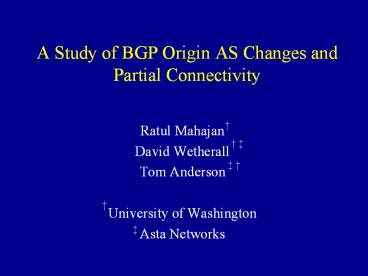A Study of BGP Origin AS Changes and Partial Connectivity - PowerPoint PPT Presentation
Title:
A Study of BGP Origin AS Changes and Partial Connectivity
Description:
A Study of BGP Origin AS Changes and Partial Connectivity – PowerPoint PPT presentation
Number of Views:43
Avg rating:3.0/5.0
Title: A Study of BGP Origin AS Changes and Partial Connectivity
1
A Study of BGP Origin AS Changes and Partial
Connectivity
- Ratul Mahajan
- David Wetherall
- Tom Anderson
- University of Washington
- Asta Networks
2
Goals
CSE
- Long-Term What is the extent and impact of
configuration errors in BGP? - incorrect origin AS, partial connectivity, pvt.
ASN, pvt. address space, looping AS-paths, - This talk
- Origin AS Changes
- Partial Connectivity
3
Origin AS Changes
- Why does the origin for a prefix change?
- How many changes are short-lived?
- How many changes are a result of
misconfiguration? - How many changes lead to reachability problems?
- Easy ways to detect misconfigured origins?
- Multiple origins for a prefix
- misses subset space hijack
- increasingly common practice
- IRRs
- are they accurate?
4
IRR Simple Way to Detect Incorrect Origins?
BGP Table Snapshot Sep 28, 2001
Verified using RADB, RIPE, APNIC, ARIN
5
Origin Changes Methodology
- Use BGP snapshots archived by Route Views
- Identify prefixes that are not announced by the
same origin(s) throughout the day - includes prefixes not present in all snapshots
- Attribute a cause to every origin change
- Caveat would miss origin changes that come and
go between snapshots
6
Classification of Origin Changes
Long-lived Changes that seem permanentFluctuati
ng Short-lived changes with correct
originsConflicting Short-lived changes with
potentially incorrect origins
7
Glossary for Short-Lived Changes
8
Weekend
1. More than 2 of the prefixes experience a
change2. Less than a third of changes are
long-lived 3. Weekly pattern in the number of
changes seen
9
1. 85 of long-lived changes persist beyond a
week2. Most action is in more-specifics
(added,deleted)
10
9/11, As Seen by Origin Changes
11-Sep
11
Self Deaggregation causes more origin changes
than failures
12
Deaggregation in general, and extra last hop in
particular, causes most changes
13
Consulting the IRR when you see conflicts does
not help
14
Some Examples of Misconfigurations
- Small ASs announce /8s (61.0/8, 62.0/8, ...)
- An AS in Romania originated routes for most of
Romania but NO reachability problems - ASs accept their own deaggregated address space
adverts, and pass them on - Not all origin misconfigurations cause
reachability - problems. How to figure out which ones do?
15
Reachability Test
- 1. Download the current BGP table
- 2. Identify the announcements with new origins
- 3. Divide the ASs into two sets
- converts ASs that believe the new origin
- loyals ASs that believe the old origin
- 4. Use public looking glass servers to check if
one set can reach the prefix while the other
cannot
16
Reachability Test Possible Results
- Pass
- both sets can reach the prefix, or
- both get blocked at the same place in the network
- Inconclusive
- both sets cannot reach the prefix, and get
blocked at different places in the network - Fail
- one set can reach the prefix, while the other
cannot
17
Reachability Test Initial Results
18
Partial Connectivity
- Advertised address space not reachable from all
places in the Internet - Causes
- convergence delays
- route flap damping
- policy
- filtering (prefix length, commercial
relationships) - Failures do not lead to partial connectivity
19
Partial Connectivity Methodology
- 1. Identify partially connected address space (!
prefix) from the BGP table - 2. Consult BGP snapshots 15 minutes before and
after to identify partial connectivity due to
convergence delays - 3. Correlate against partial connectivity across
days to differentiate between route flap damping
and filtering based partial connectivity - 4. Verify using public looking glasses to guard
against restrictive export policies and default
pointing
20
Partial Connectivity Results
- Expressed as age of advertised address space
- convergence 0.005-0.02
- route flap damping 0.1-0.8
- filtering 0.7
21
Most partially connected prefixes are /24sMost
partially connected address space is due to /16s
22
Conclusions
- More than 2 of the prefixes experience an origin
change during the day - Less than a third of the changes are long-lived
- Only a small fraction of the changes lead to
reachability problems - 0.7 of address space is partially connected
- Feedback http//www.cs.washington.edu/homes/ratul
/bgp/ltratul_at_cs.washington.edugt































